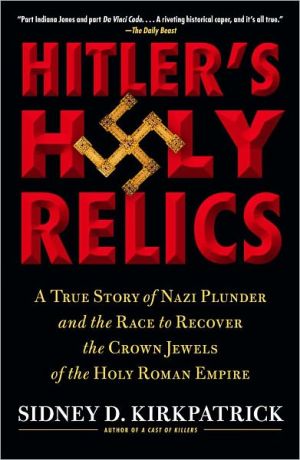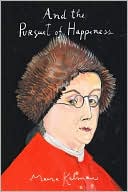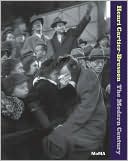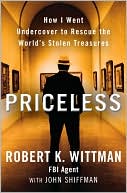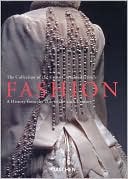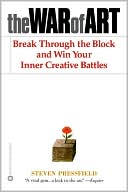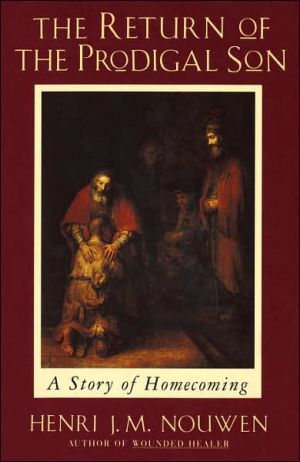Hitler's Holy Relics: A True Story of Nazi Plunder and the Race to Recover the Crown Jewels of the Holy Roman Empire
From Paris to Stalingrad, the Nazis systematically plundered all manner of art and antiquities. But the first and most valuable treasures they looted were the Crown Jewels of the Holy Roman Empire. In Hitler’s Holy Relics, bestselling author Sidney Kirkpatrick tells the riveting and never-before-told true story of how an American college professor turned Army sleuth recovered these cherished symbols of Hitler’s Thousand-Year Reich before they could become a rallying point in the creation of a...
Search in google:
A real life Raiders of the Lost Ark. An American art historian turned Army sleuth races to stay one step ahead of Nazi thugs who have absconded with the Crown Jewels of the Holy Roman Empire—sacred symbols of Hitler’s “Thousand Year Reich”—and their plot to create a Fourth Reich.Publishers WeeklyIn this fast-paced history, Kirkpatrick (A Cast of Killers) describes the efforts of German-born Walter Horn, a U.S. Army first lieutenant and art historian, to locate the missing crown, orb, scepter, imperial sword, and ceremonial sword of the Holy Roman Empire in Europe at the end of WWII. The objects, along with the Holy Lance of Longinus and many other artifacts, had been stolen by the Nazis from Austria after the Anschluss in 1938 and, conceivably, could have been used by Nazis to motivate Germans in the creation of a “Fourth Reich.” Through research, investigation, and amateur detective work, Horn explored the continuing threats inherent in Nazi mythology while successfully solving the core mystery of the disappearance of the crown jewels. Definitely speculative in the suggestion that a mysterious new order of “Teutonic Knights” might exist for malevolent political purposes, Horn's story is an interesting footnote to the history of WWII. 24 pages of b&w photos; 2 maps. (May 11)
CHAPTER 1BLACKSMITH’S ALLEY\ February 23, 1945\ Every morning, like clockwork, Allied bombers would darken the skies over Namur, Belgium. In this last winter of World War II, hundreds and sometimes a thousand planes, flying in vast air armadas known as bomber streams, would thunder overhead for an hour or more at a time, leaving miles-long vapor trails that hung in the air long after the aircraft had vanished and the bombardiers had released their lethal cargo over targets in Germany and Eastern Europe.\ The arrival of the bomber streams terrified the captured German soldiers at the U.S. Army detention center in the snow-covered fields on the outskirts of Namur. The prisoners, huddled together and shivering in wire-mesh holding pens, would peer anxiously sky-ward, dreading the horror about to be unleashed on their friends and families at home. Their American captors would also look up at the planes, but instead of fear, they felt overwhelming admiration for the bomber crews and their firepower. They were the silver hammer that was destroying the Nazi war machine and would soon enable the Allied Army to annihilate Adolf Hitler in his homeland. That the day and night bombing missions targeted not only military objectives but also industrial sites, resulting in the destruction of entire cities, was the price that Germany had to pay for its continued resistance.\ First Lieutenant Walter Horn, one of ten German-speaking U.S. Third Army interrogators stationed at Camp Namur, awaited the daily arrival of the bomber squadrons with mixed emotions. Thirty-six years old, with a broad chest and shoulders, dark movie-star looks, and an impatient wife waiting at home in Point Richmond, on the San Francisco Bay, Horn felt tremendous pride in America’s ability to build, fuel, maintain, and launch thousands of planes loaded with tens of thousands of bombs, hurtling them hundreds of miles deep into enemy territory. Although he had yet to fire a weapon in combat during two years of service, and his mobile intelligence unit, commanded by General George S. Patton, always remained a comfortable fifty miles behind the front lines, Horn appreciated the daring and courage of the air crews and felt a special kinship with the thousands of others—artillerymen, infantry, medics, cooks, clerks, and quartermasters—who made up the largest, fastest-moving, and best-equipped army that had ever existed.\ But the sight of the bomber streams also filled Horn with anxiety. Like the prisoners he interrogated, he had been born, raised, and educated in Germany. He never knew whether one of the bombers would be dropping its payload within range of his family’s home in Heidelberg or if, as he looked into the holding pens at the forlorn faces of captured and wounded prisoners, he would one day see the face of his older brother Rudolf.\ Lieutenant Horn’s orders that winter were to help ascertain whether Hitler would unleash chemical or biological weapons when the Allied Army crossed the Rhine River into the German heartland. It had been rumored that the Germans, in a last desperate attempt to break the vise of the approaching Allied forces, would resort to using such weapons, as they had in the trenches in France twenty-seven years earlier.\ Patton’s mobile intelligence unit had prepared a detailed questionnaire to ferret out the truth. Interrogators did not ask prisoners directly about weapons stockpiles. Rather, they elicited the information from four out of one hundred fifty seemingly random questions put to the prisoners. The answers would be used to determine if the soldiers had been taught how to use chemical or biological weapons in battle and if, hidden behind enemy lines, shelters were in place to protect the civilian population. Fifteen hundred rank-and-file soldiers, selected from Wehrmacht infantry captured in Belgium after the Battle of the Bulge, had been marched to Namur for this purpose. The interrogation facilities being inadequate, many of the interviews took place out of doors. Horn’s office, just beyond the prisoner enclosures, consisted of two empty orange crates, a small desk borrowed from a nearby elementary school, and a stack of questionnaires and pencils.\ Horn had already interviewed thirty-five prisoners on February 23, 1945, when a camp guard brought him forty-eight-year-old Private Fritz Hüber from the German 2nd Panzer Division. Lean and haggard, with a narrow face distinguished by an enormous hooked nose, Hüber wore the same ill-fitting uniform in which he had been captured three weeks earlier. Though old by Allied Army standards, Hüber was not an unusual Wehrmacht recruit, as the Germans, after more than five years of continuous warfare, were drafting soldiers as young as sixteen and as old as sixty, mixing them into units of battle-hardened veterans and having them dig trenches, run interference, and haul equipment on their backs or in carts. German manpower, a resource like the diesel fuel to drive their tanks, was now in short supply.\ Hüber, recruited in Nürnberg, had received less than a month’s training before being marched through the snow into combat in Belgium; he didn’t know anything about chemical or biological weapons. Horn checked off the private’s answers in rapid succession, obtaining nothing more than “yes,” “no,” and “I don’t know.”\ The interview completed, Horn was ready to dismiss his prisoner. But as the lieutenant would later note in a detailed account of the interview, he suddenly changed his mind. Looking across the table at the pitiful Private Hüber, hunched over from lack of sleep and clearly suffering from rheumatism in the damp cold, Horn offered Hüber a cigarette and a cup of coffee and asked if there was anything he knew that might interest Army intelligence.\ Hüber contorted his face like a schoolboy who had flunked an exam. Tears welled up in his eyes. He wanted to help, to be of service.\ The lieutenant had witnessed reactions of this kind before. He saw it nearly every day among prisoners who had lost everything but their lives. Men like Hüber, recruited off the streets by the Gestapo or forcefully removed from their homes and pressed into service for the Fatherland, were neither dedicated nor arrogant Nazis. Many of them had already lost sons, daughters, and wives in the war or had seen their homes and apartment buildings incinerated. They were reluctant warriors. Having given themselves up to the enemy, been stripped of their possessions, and herded like cattle into holding pens, most had lost the last shreds of self-respect. As a final indignity, they now saw and heard the endless streams of bombers overhead and knew that their situation was truly hopeless. Hermann Göring’s new and much-vaunted Messerschmitt jet interceptors were nowhere to be seen. If Hitler actually possessed a secret weapon that would turn the tide of the war, as propaganda minister Josef Göbbels had promised the German people, he would have used it by now.\ Hüber and his fellow prisoners knew that no one would be coming to their rescue. Yet, despite their utter despair, Horn sensed a strange paradox in them. These footsoldiers, even those who had begun as stalwarts of the Führer’s insane dream of world domination, still wanted to be of service, wanted to count for something. They were desperate to be of value, even if it was to the enemy. Private Hüber and countless others like him would be the ones who would one day return home to rebuild their nation.\ The prisoner told Horn, apologetically, that he could be of no help.\ Horn expected to hear nothing more from him. But as Hüber finished his coffee, and Horn was about to signal to camp guards to lead him back to the prisoner enclosure, the soldier’s face suddenly lit up. “Are you interested in art and antiques?” Hüber asked.\ Horn smiled broadly. The aging German soldier couldn’t have known that in civilian life his interrogator was an art history professor at the University of California at Berkeley or that years earlier, before fleeing Nazi Germany, he had studied art history in Hamburg, Munich, and Berlin, had earned his doctorate under the mentorship of the internationally renowned medieval scholar Erwin Panofsky, and completed postgraduate work with Bernard Berenson in Florence, Italy. There was no subject that Dr. Walter Horn was more interested in discussing than art and antiquities.\ “What do you know?” Horn asked.\ Hüber sat up stiffly and addressed the lieutenant as if he was being debriefed by a superior in the German Army. “There is a hidden treasure in a bunker underneath the Nürnberg castle. The hiding place is cut into the rock under the sandstone cliff. It’s very secret. No one but Reichsführer Himmler, his staff, a few ranking city officials, and workers who labor in the bunker know anything about it.”\ “Heinrich Himmler, you say? Of the SS?”\ Hüber nodded solemnly, adding that the bunker was deep in the castle’s bedrock but that its entrance tunnel was from outside, on the street.\ Intrigued, Horn asked Hüber to elaborate.\ Hüber explained that the entrance was camouflaged to look like the parking garage of an antiques shop off an alley in the old part of the city, with a sign that read Antiques—New and Old.\ As Horn would later note, Hüber paused as if holding an image of the shop in his mind. The thought seemed to bring a faint smile to his face. He became more relaxed, even upbeat.\ The prisoner continued by describing the bunker’s layout. He said that the covered car park, with its camouflaged doors, led to a long tunnel that descended some two hundred feet underground. At the end of the tunnel was a four-thousand-square-foot bunker, constructed of reinforced concrete, with five separate storage cells and a bank vault large enough to park a small truck inside. The facility was entirely self-contained. The bunker’s guards had their own sleeping quarters, electric generators, fuel, fresh water, food supply, and radio equipment. There were airshafts that opened aboveground and an air-purification system in case the city was fire-bombed.\ “If this place is so secret,” Horn asked warily, “How did you get to know about it?”\ Hüber’s face now became animated. “Because our family lives above the antiques shop. My father is in charge of maintaining the ventilation unit that regulates the bunker’s temperature and humidity. Mother checks the art and artifacts for possible mold and insect damage. She has to wear special white gloves when entering the storage units. Every now and again, she sprays the facility with pesticide.”\ Horn listened with growing fascination as Hüber discussed a few of the bunker’s elaborate security features. Even the guards protecting the facility could not access the storage units, and no unaccompanied person, except for Himmler and the lord mayor of Nürnberg, Willy Liebel, was ever permitted inside the vault room. Two keys and a five-digit lock combination were necessary to open its foot-thick outer door and a second inner door with steel bars.\ “What kind of art is kept inside the bunker?” Horn asked.\ Hüber mentioned several of the more than a hundred objects he said were sheltered in the various storage rooms. There were prints and etchings by Albrecht Dürer, sculpture by Adam Kraft and Viet Stoss, medieval codices, maps, Renaissance musical instruments, and Gothic stained-glass windows. Everything was listed in a card catalogue outside the guard’s room, in the main hall, and checked periodically by the lord mayor or his secretary.\ Impressed, Horn asked what was kept in the vault room.\ Hüber was immediately forthcoming. Inside was an array of artifacts packed into wooden shipping crates. In one enormous box containing a glass case were a king’s robes, embroidered with pearl-studded pictures of camels and lions. Another box, with the word “Mauritius” stenciled on the side, held an ancient sword. A third box contained a crown covered with uncut sapphires, rubies, and amethysts. Nearby was stored a silver scepter and a golden apple tipped with a jewel-encrusted cross. In its own leather case, resting on a red velvet pillow, was an ancient Roman spear point, which visitors to the vault—among them Himmler himself—referred to as the “Holy Lance.”\ Horn was both excited and disturbed by Hüber’s recitation. He didn’t have enough information to identify the origins of the artwork sheltered in the rest of the bunker, but the combination of treasures in the vault belonged to a legendary collection of artifacts that had been detailed in countless medieval paintings and monastic manuscripts.\ The king’s robes, or imperial vestments, embroidered with the distinctive camels and lions, had been created in the early twelfth century in Palermo, Italy, and had been worn by the great soldier-kings of medieval Europe. The imperial sword—sometimes referred to as the “Mauritius sword”—was named in honor of a martyred Roman centurion and legendary commander of the Theban Legion. The crown, scepter, and apple-shaped orb had been the property, among others, of King Frederick Barbarossa, the fearsome red-bearded monarch who had once held court in Nürnberg Castle and lost his life during the Third Crusade to the Holy Land. But it was Hüber’s mention of the ancient Roman spear point that authoritatively identified the collection. The Holy Lance, known variously as the Longinus lance and Spear of Destiny, was alleged to have been the weapon that pierced the side of Christ at the Crucifixion and had subsequently been carried into battle by Emperors Constantine and Charlemagne.\ The objects in the vault were the Crown Jewels of the Holy Roman Empire, the most valuable collection of artifacts in all of Europe. Hitler, in his quest for world domination, had removed them from the royal treasury in Vienna, Austria, and put them briefly on display in Nürnberg. Where he had hidden them after the bombing raids over Germany began, and if the collection was still intact, was a subject of intense speculation among art historians and museum curators the world over.\ Horn had no reason to doubt the prisoner’s story. Hitler had plundered Europe, stealing all manner of treasure, from Leonardo paintings and Michelangelo sculptures to priceless Russian and Polish icons and medieval monastic manuscripts. Nürnberg, the second-largest city in Bavaria, was a natural place for Hitler to safeguard his plunder. This ancient city, with its massive medieval castle built on a red sandstone mountain, was the Nazi state’s symbolic core, sentimentally linked with its perceived mythic past, and the site of enormous staged Nazi Party rallies to glorify the regime’s future. Horn himself, over the radio, had heard Hitler, standing at a podium, declare Nürnberg to be “the most German of all German cities” and “the treasure chest of the Nazi Party.” Horn had always thought he meant this figuratively. Hüber was telling him otherwise.\ The prisoner dutifully wrote down the names of his mother and his father, then drew a map on the back of an Army questionnaire detailing the exact location of the entrance to the underground bunker on a narrow lane that at one end backed against the historic Nürnberg castle and at the other, an open cobblestone square and clusters of medieval buildings that included the former home and art studio of Albrecht Dürer. The address was “52” Upper Black-smith’s Alley.\ Later that evening, after Horn had returned a stack of questionnaires to his commanding officer, he borrowed a typewriter from his friend and fellow German-born interrogator, Master Sergeant Felix Rosenthal, and spent the rest of the night in the officers’ mess composing a detailed account of his interview. He had every reason to believe that his report would be buried in a slush pile of Army intelligence dismissed as unimportant to the war effort, and if for some reason it was passed up the chain of command to General Patton’s headquarters, he knew how improbable it would be that a combat operations officer would recognize the recovery of the Crown Jewels of the Holy Roman Empire as a significant military objective.\ In spite of his doubts that his report would climb the chain of command, Horn wrote two drafts, composing his words with the same care and attention to detail as for articles he had published in prominent art history journals before the war. Satisfied with the final result, he sealed his report along with Hüber’s hand-drawn map into an envelope and addressed it to Patton’s Third Army intelligence headquarters in Paris.\ © 2010 Sidney D. Kirkpatrick
Author's Note XI\ 1 Blacksmith's Alley 1\ 2 Monuments Men 9\ 3 Camp Ritchie Boys 26\ 4 Invasion of Nürnberg 36\ 5 Thor's Hammer 46\ 6 Pandora's Box 59\ 7 Spear of Destiny 77\ 8 Himmler's Scholars 92\ 9 The Aryan Jesus 107\ 10 Hitler's Fairy-Tale Kingdom 118\ 11 Teutonic Knights 126\ 12 The Enemy At the Gates 135\ 13 Chain of Command 145\ 14 Himmler's Courier 152\ 15 Keys to the Vault 158\ 16 Hitler's Holy Reich 171\ 17 Externsteine 181\ 18 Black Camelot 193\ 19 The White House 204\ 20 Nazi Plunder 215\ 21 Camp King 224\ 22 The Crown Jewels 234\ 23 The Faustian Bargain 241\ 24 The Fourth Reich 251\ Epilogue 263\ Acknowledgments 273\ Notes 277\ Index 297
\ From the Publisher“Tales of art stolen and then recovered or lost forever make for an intriguing drama of the Second World War. Hitler’s Holy Relics paints one such story . . . complete with a bold hero, a post-apocalyptic backdrop, a subplot out of Indiana Jones, a treasure worth dying for, and a classic locked-room mystery at its heart. . . . A crackling good story.”\ —Noah Charney, Artinfo.com\ “Tales of art stolen and then recovered or lost forever make for an intriguing drama of the Second World War. Hitler’s Holy Relics paints one such story . . . complete with a bold hero, a post-apocalyptic backdrop, a subplot out of Indiana Jones, a treasure worth dying for, and a classic locked-room mystery at its heart. . . . A crackling good story.”\ —Noah Charney, Artinfo.com\ “A vivid true-crime narrative about a post–World War II investigation meant to prevent Nazis still at large from using several venerable medieval artifacts to reconstitute the Reich. . . . Fast-moving and intriguing, in the vein of Raiders of the Lost Ark.”\ —Kirkus Reviews\ “A riveting narrative that is as exciting as a well-crafted novel. . . . Sidney Kirkpatrick paces his book about the case of the vanishing jewels with such skill that it grabs readers by the scruff of the neck and does not let go until the very last page.”\ —Larry Cox, King Features Syndicate\ \ \ \ \ \ Kirkus ReviewsFrom filmmaker Kirkpatrick (The Revenge of Thomas Eakins, 2006, etc.), a vivid true-crime narrative about a post-World War II investigation meant to prevent Nazis still at large from using several venerable medieval artifacts to reconstitute the Reich. In early 1945, Lt. Walter Horn-an expatriate from the Fatherland with an academic background in art history-learned of a bunker underneath Nuremberg's castle housing secret treasures, known to only a few, including Heinrich Himmler. Before long, Horn received orders to locate five crown jewels of the Holy Roman Empire that had gone missing from the "Blacksmith's Alley" bunker, part of a larger cache that Hitler had seized from Austria near the beginning of the war. Of particular interest was the "Holy Lance" of Longinus, reputed to have pierced Jesus' side at the Crucifixion. Using military records, correspondence, diaries, interviews and archival materials, Kirkpatrick shows how scholar-soldier-sleuth Horn overcame a foot-dragging American captain whose own sloppy supervision had caused the relics' loss, former Nazi functionaries reluctant to divulge all they knew and an Allied Occupation authority anxious to establish their competence before a starving, resentful population. In the process, he throws light on how Hitler's obsession with "cherished symbols of the medieval concept of world government" probably influenced the dictator's henchmen, who not only created a pseudo-scholarly think tank about the nation's Aryan past but also Nuremberg's Nazi parade grounds in the shape of the Holy Lance. Kirkpatrick also considers the possibilities that Himmler formed a Teutonic brotherhood of knights to protect the treasure and that Hitler'sdeluded interpretation of the relics might have helped him justify the Holocaust. Fast-moving and intriguing, in the vein of Raiders of the Lost Ark. Agent: Richard Morris/Janklow & Nesbit\ \ \ Publishers WeeklyIn this fast-paced history, Kirkpatrick (A Cast of Killers) describes the efforts of German-born Walter Horn, a U.S. Army first lieutenant and art historian, to locate the missing crown, orb, scepter, imperial sword, and ceremonial sword of the Holy Roman Empire in Europe at the end of WWII. The objects, along with the Holy Lance of Longinus and many other artifacts, had been stolen by the Nazis from Austria after the Anschluss in 1938 and, conceivably, could have been used by Nazis to motivate Germans in the creation of a “Fourth Reich.” Through research, investigation, and amateur detective work, Horn explored the continuing threats inherent in Nazi mythology while successfully solving the core mystery of the disappearance of the crown jewels. Definitely speculative in the suggestion that a mysterious new order of “Teutonic Knights” might exist for malevolent political purposes, Horn's story is an interesting footnote to the history of WWII. 24 pages of b&w photos; 2 maps. (May 11)\ \ \ \ \ Booklist“A fast moving account filled with surprising twists, turns, and revelations.”\ —Booklist\ \ \ \ \ Booklist“A fast moving account filled with surprising twists, turns, and revelations.”\ —Booklist\ — Jay Freeman\ \ \ \ \ Library JournalKirkpatrick (A Cast of Killers) has brought his fast-paced narrative style to the story of Lt. Walter Horn, the German-born American art professor tasked with recovering the crown jewels of the Holy Roman Empire, which had been stolen by the Nazis, were hidden away during the war, and were then missing after the fall of Nazi Germany. Based largely on the testimony and archives of Horn himself, this is an intriguing story for those interested in the plunder and fate of Europe's cultural artifacts during and after World War II. Kirkpatrick tends to overdramatize the importance of his subject, offering without proof the thesis that the crown jewels—pieces associated with the coronation of the Holy Roman Emperor—could have served a powerfully symbolic purpose for the Nazis and then any neo-Nazi groups in the postwar period. Much of the book is redundant conjecture about Nazi motives surrounding the use of the jewels. VERDICT Those who'd prefer a more systematic treatment of this subject would be better served by Lynn H. Nicholas's The Rape of Europa: The Fate of Europe's Treasures in the Third Reich and the Second World War or Robert M. Edsel and Bret Witter's The Monuments Men: Allied Heroes, Nazi Thieves, and the Greatest Treasure Hunt in History. Readers who enjoyed those works and would like a more personalized account of one of the players in the drama will enjoy Hitler's Holy Relics. (Index not seen.) [See Prepub Alert, LJ 1/10.]—Michael Farrell, Reformed Theological Seminary Lib., Oviedo, FL\ \
